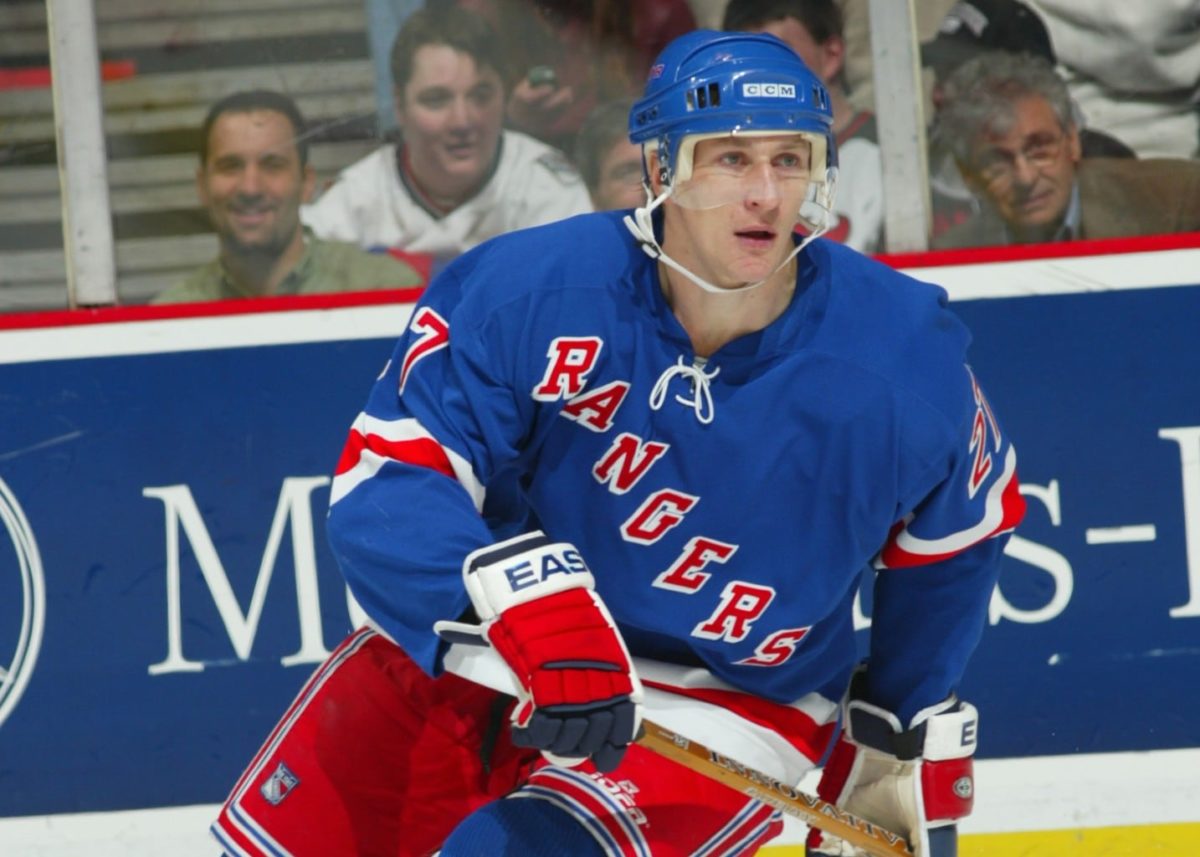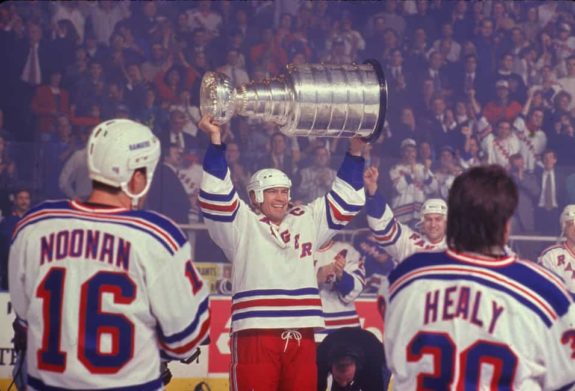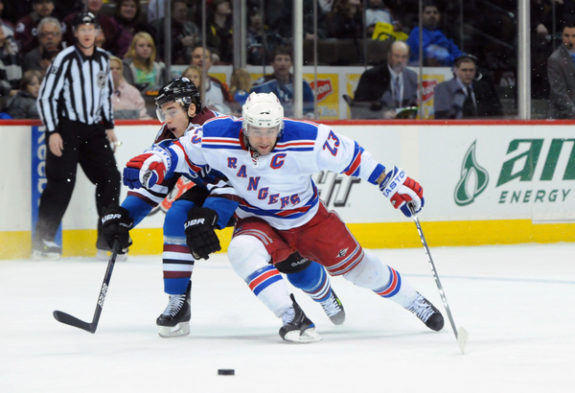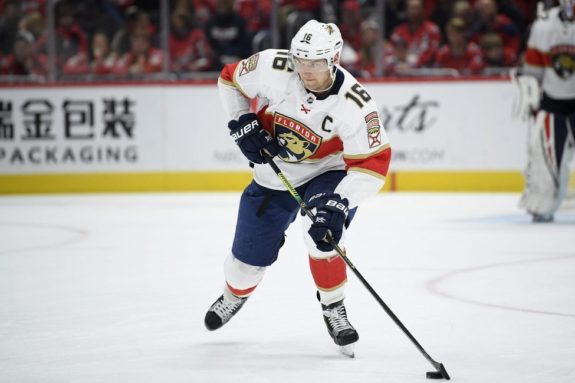The image is one on which New York Rangers fans can dream: A superstar 1-2 punch at center next season, with the resurgent Mika Zibanejad and Jack Eichel or perhaps Alexander Barkov sparking barstool arguments about which player is the top man in the middle for the Blueshirts, and which is the 1A – certainly, a pleasant problem to have.
Yet, it is just an image at this point, one that exists in a vacuum. Because none of those three elite talents, all connected to the Rangers via trade rumors for the past several months, are likely to arrive on Broadway for anything less than a significant price in players, draft picks and salary-cap space.
So new general manager Chris Drury will have to carefully weigh the possibility of upgrading his team’s questionable center corps this summer via a blockbuster acquisition, taking those factors into account. It’s a lot to process. Fortunately for the Blueshirts faithful, Drury’s life has intersected twice with a very similar situation, giving the lifelong Rangers fan a possible template off of which to work.

The Connecticut native was just shy of his 16th birthday during the 1992 NHL Draft. That’s when his favorite team thought it had completed a trade for the rights to 1991 top overall draft pick Eric Lindros, perhaps the most hyped prospect in league history who had vowed to never play for the Quebec Nordiques, who had selected him. The Rangers, of course, ended up losing out on Lindros then, as Nordiques ownership had also agreed to deal him to the Philadelphia Flyers, a trade which an arbitrator later ruled to be the valid one.
It’s likely that Drury, as with all Rangers fans at that time, fumed over losing out on the player dubbed The Next One. Twenty-nine years later, Drury has been afforded plenty of perspective on that seminal moment in NHL history – which could greatly benefit his decision-making now.
Rangers May Have Lucked Out in Losing Lindros Sweepstakes
For one, Lindros never won a Stanley Cup, the Rangers would go on to break their 54-year championship drought two years later – with one of the players who would have gone to Quebec for Lindros playing a key role on the ice, and others being used in trades that brought back components critical to their Cup run.
Looking back now, the bounty the Rangers would have surrendered to acquire Lindros was exorbitant. In an interview last year, then-general manager Neil Smith confirmed the assets that would have headed north: forwards Alex Kovalev, Tony Amonte and Doug Weight, defenseman James Patrick or goaltender John Vanbiesbrouck (contingent on Vanbiesbrouck’s free-agent status that offseason), two first-round draft picks and $20 million.
Seen through the lens of today’s salary-capped NHL, the talent drain looks shocking. Even then, the price was steep. Kovalev, who totaled 1,029 career points, played a crucial role in the ’94 Cup run. Amonte, who had racked up 68 goals and 77 assists in his first two seasons as a Ranger, would record 416 goals and 900 points in a 1,174-game career, primarily for the Chicago Blackhawks. Weight recorded 1,033 points.

For those Rangers, the value of Amonte, Weight and Patrick was in different trades, ones that yielded Stephane Matteau, Brian Noonan, Steve Larmer and Esa Tikkanen to fortify the Rangers for the championship run – moves that now live in franchise lore.
Had those players departed for Quebec, would the Rangers have broken their curse? Mark Messier and Lindros down the middle would have been the envy of the league. Yet the high-end depth used on the ice and in deals to give the Blueshirts just enough to push them over the championship finish line would have been gone. The organization and, specifically, the forward corps around Messier, new arrival Lindros, Adam Graves and Brian Leetch would have been left significantly depleted.
Given that, the question for Drury should be whether trading from the current Rangers’ impressive pool of young talent for one player will make the club significantly better than if he doesn’t make a trade at all. Smith readily admits he was desperate to do just that in June 1992.
“I know it seems like a lot (to send away), and it would have been, but you have to remember that Lindros was going to be The Next Great One, and everyone, starting with our ownership and (team governor) Stanley Jaffe, wanted him badly,” Smith said.
“And even though I wouldn’t have been jumping up and down with glee at trading all of those young assets, we would have been getting a special player we all thought was worth it. Remember, Eric was 19.” (From ‘Failed Eric Lindros Trade Is The Rangers’ Greedy Dynasty Long Shot’, New York Post, 5/29/20)

We’ll never know if those Blueshirts would have had enough depth around those star players to win the Cup anyway. It’s probably unfair to harp on the fact that Lindros never won a championship despite playing on some formidable Flyers teams. What did happen, the Rangers winning their first Stanley Cup since 1940 in a playoff run that represents one of New York’s great sports moments, occurred in large part because of the players who remained instead of going to Quebec.
Drury’s Time With Avs Put Him Up Close With Lindros Trade Again
By incredible happenstance, Drury possesses even more perspective on this topic, this portion coming first-hand. In his third NHL season in 2000-01, Drury was a key member of the Cup-winning Colorado Avalanche, recording 65 points in the regular season and 11 goals and five assists in the playoffs.
The Avalanche, of course, were the Nordiques until the 1995-96 season, when they moved to Denver. Differently than the Rangers, Colorado was reaping its own big benefits from Quebec’s trade of Lindros: Those powerhouse Avs boasted Peter Forsberg, Mike Ricci and Chris Simon – all a part of the Nordiques’ haul from the deal. Forsberg – Drury’s teammate in 2000-01 – compiled more career points than fellow Hall of Famer Lindros (885-865) and had arguably the better career, while Ricci and Simon were key contributors when Colorado won its first Stanley Cup in ’96.

Plus, similar to the Rangers – albeit in a convoluted way – Colorado used some of the assets from the trade to bolster its championship hopes further. The 1993 first-round pick from the Flyers was used on goaltender Jocelyn Thibault, who was part of the Dec. 1995 trade for goalie Patrick Roy, who would backstop both Avs championships – a deal that also brought defensive-minded forward Mike Keane from the Montreal Canadiens. Colorado turned veteran netminder Ron Hextall into its second ’93 first-round pick that became key forward Adam Deadmarsh.
Would the Avalanche have won two championships had Lindros agreed to join the Nordiques, eventually manning the middle with Joe Sakic? Possibly, but the question of adequate remaining depth again comes into play again in that hypothetical scenario. What did happen was Colorado getting the better of the swap – using the substantial trade capital to build a roster that would capture multiple Stanley Cups.
So Drury saw all three sides of that instructive trade. It was the two teams in that early 90s saga that didn’t end up with Lindros who reached the top of the mountain – not the club that acquired the biggest name in the deal. How much will that inform the first-time GM’s plans?
The Rangers are rumored to have made the Buffalo Sabres an offer for Eichel last offseason, but a potential trade fell apart when former GM Jeff Gorton wasn’t willing to accede to the Sabres’ demands for the No. 1 overall pick. The price for Eichel may come down after a season in which he played only 21 games due to a neck injury, but Drury is still sure to have competition for Eichel’s services.
Should the Florida Panthers look to cut salary, the cost for Barkov, who might be the better fit for the Rangers, will also be high. Evgeni Malkin might also be available this offseason, but it seems like more of a longshot, and the Pittsburgh Penguins aren’t going to just give the future Hall of Famer away.

Will Drury sacrifice youngsters such as Kaapo Kakko, Vitali Kravtsov, K’Andre Miller and others to consummate a deal? Does he fear those players going elsewhere and becoming Amonte, Weight, Kovalev – or Forsberg? Like his predecessor Smith, he’ll have to mull the danger in giving away young, high-ceilinged pieces acquired through the Rangers’ rebuild that could form part of a future championship core to upgrade one area – albeit with an established star.
Look for Drury to Play Hardball in Trade Negotiations for Center
The Rangers’ current pursuit of a center hardly presents an exact parallel to their chase for Lindros back then. Though young, Eichel and Barkov are largely known quantities, making it easier for the Blueshirts’ front office to assign a value to those players and stick with it – as they apparently did last summer. Lindros, as a teenager, stirred the imagination and the possibility that his career would approach that of Wayne Gretzky’s or Mario Lemieux’s, thus driving his price into the stratosphere. It’s worth pointing out that that might have happened had Lindros remained healthy, validating the hype around him, but head injuries left his career diminished.
Latest Rangers Content:
- New York Rangers’ 4 Best Contracts for 2024-25
- Rangers Need Miller/Schneider Pair to Take Big Step in 2024-25
- A Hockey Fan’s Travel Guide to New York City
- Rangers’ Zibanejad Must Prove Doubters Wrong With Bounce Back in 2024-25
- 9 NHL Teams That Missed in Free Agency
The lesson of the Lindros chapter, though, should still apply today, especially when roster depth is more critical than ever in the era of the salary cap – one that may remain flat for the foreseeable future.
It seems impossible that it will be lost on Drury. The 44-year-old saw the importance of such depth as he celebrated his favorite team winning it all as a kid and then lived it as his first NHL team added Drury’s name to the Stanley Cup, thanks in part to the trade of Lindros. Fate appears to have rendered him the perfect person to make this decision in the coming months.

Here’s betting the insightful Drury, now in possession of his dream job, refuses to be fleeced for any of the aforementioned big names. Given his experiences and unique intimacy with a similar situation in the past, it would hardly be a surprise.